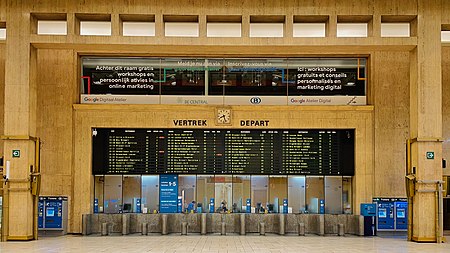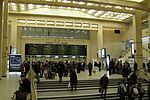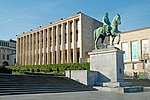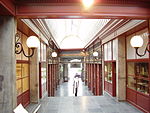Brussels Central Station

Brussels Central Station (French: Gare de Bruxelles-Central, Dutch: Station Brussel-Centraal), officially Brussels Central (French: Bruxelles-Central, Dutch: Brussel-Centraal), is a railway and metro station in central Brussels, Belgium. It is the second busiest railway station in Belgium and one of three principal railway stations in Brussels, together with Brussels-South and Brussels-North. First completed in 1952 after protracted delays caused by economic difficulties and World War II, it is the newest of Brussels' main rail hubs. Brussels Central is connected to the Gare Centrale/Centraal Station station on lines 1 and 5 of the Brussels Metro system, and serves as an important node of the Brussels Intercommunal Transport Company (STIB/MIVB).
Excerpt from the Wikipedia article Brussels Central Station (License: CC BY-SA 3.0, Authors, Images).Brussels Central Station
Cantersteen - Kantersteen, City of Brussels Pentagon (Brussels)
Geographical coordinates (GPS) Address Nearby Places Show on map
Geographical coordinates (GPS)
| Latitude | Longitude |
|---|---|
| N 50.845555555556 ° | E 4.3569444444444 ° |
Address
Bruxelles-Central - Brussel-Centraal
Cantersteen - Kantersteen
1000 City of Brussels, Pentagon (Brussels)
Belgium
Open on Google Maps











